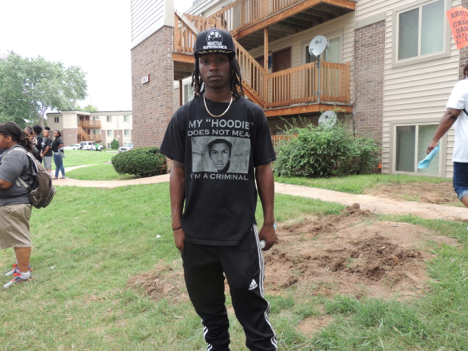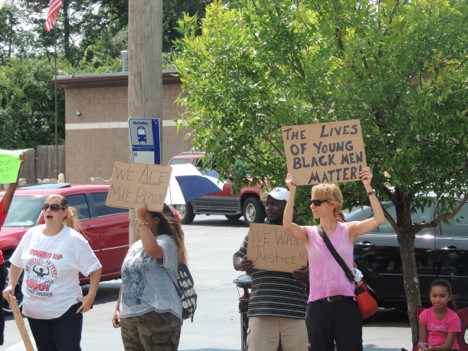About two weeks ago, a group of six of us from Syracuse joined other Black organizers, cultural workers, healers, etc. from all across the country for a weekend of national action in Ferguson. According to the organizers, “the Black Life Matters Ride was organized in the spirit of the early 1960s interstate Freedom Rides to end racial segregation.” Prior to going to Ferguson that weekend, like many other people, I could not take my eyes off of what was happening there. When my friend and colleague Sherri Williams, a PhD candidate and journalist asked if I wanted to, I gave a resounding “yes!”
We arrived in Ferguson on the Saturday of the nation-wide march. Even though I had seen the footage, the photos, read the reports, I still wasn’t sure what to expect when we arrived. We parked our van in a shopping center and then we walked down West Florissant, a main street in the city. As we walked to place where everyone was gathering to meet for the march, we passed by a number of boarded up storefronts with messages thanking The gray skies and clouds that hung low above our heads seemed to capture our collective state of grieving and mourning not just for Mike Brown, but for so many black folks that have been so violently killed and brutalized at the hands of the state.
The march began at the corner of West Florissant and another small street that lead towards a residential neighborhood. I was confused about why where we beginning to march into this neighborhood instead of marching down West Florissant which was wider and where I thought we would have way more visibility. We marched down the street, young, old, predominately black with a smattering of white faces, chanting “hands up don’t shoot.” As we marched down the street, the street began to narrow significantly and then the Fruit of Islam, the defense wing of the Nation of Islam, began to tell everyone to get on the sidewalk to make room for the family. My friends who were further up ahead finally told me that we were actually standing in the place where Mike Brown was killed. After people began petering out, I then saw memorial filled with caps, teddy bears, and all sorts of trinkets and tokens of affection and love. Mike Brown was somebody’s son, someone’s neighbor, someone’s friend. Mike Brown was somebody. A human being. Even though I have been to and planned plenty of solidarity demonstrations and marches, this was the first time, I was in the actual space so relatively soon after an actual life had been taken by racist, vile murderous cops.
It took me a minute to actually understand and digest where we were standing because none of the photos and reports I’d seen up to that point captured the neighborhood where Mike Brown was so callously killed. My friends and I were absolutely struck by how small and intimate the street was. Apartments were only a few feet away from the street’s edge, and the street itself was not particularly wide. It was reported that Darren Wilson stopped Brown because he was walking in the street, and when I saw how small and enclosed the was, I was enraged. As my friend and colleague Sherri repeated throughout the weekend, the fact that Darren Wilson felt empowered and entitled to shoot with such reckless abandon in such a small space shows that he didn’t just completely and utterly disregard Mike Brown’s life but he obviously had no respect for the lives of anyone in that community.
While there was so much I learned and took back with me from my trip to Ferguson, the thing that has stayed with me and what will be eternally etched in my memory is the image of that community and that space where Mike Brown was murdered. As one of the Black Lives Matter riders later said at a debriefing that evening, what was so chilling and enraging about seeing the actual community where Mike Brown took his last breaths, was that it sent the clear sign that black people are not even safe in what’s supposed to be the most sacred spaces in our society, our homes and our communities.
* * *
Click the gallery below for full images and descriptions.
My partner, Jeanelle Hope, took the photos and made invaluable suggestions to this piece.
Nikeeta Slade is on the editorial board of Red Wedge, and blogs for the site at "AfroBlazingGuns."


















